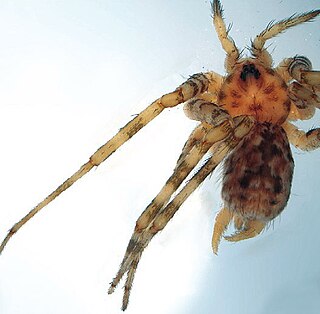
Wolf spiders are members of the family Lycosidae, from the Ancient Greek word "λύκος" meaning "wolf". They are robust and agile hunters with excellent eyesight. They live mostly in solitude and hunt alone, and do not spin webs. Some are opportunistic hunters pouncing upon prey as they find it or even chasing it over short distances. Some wait for passing prey in or near the mouth of a burrow.

Tegenaria is a genus of fast-running funnel weavers that occupy much of the Northern Hemisphere except for Japan and Indonesia. It was first described by Pierre André Latreille in 1804, though many of its species have been moved elsewhere. The majority of these were moved to Eratigena, including the giant house spider and the hobo spider.

Tree trunk spiders (Hersiliidae) is a tropical and semi-tropical family first described by Tamerlan Thorell in 1870. They have two prominent spinnerets that are almost as long as their abdomen, earning them the nickname "two-tailed spiders". They range in size from 10 to 18 millimetres long. Rather than using a web that captures prey directly, they lay a light coating of threads over an area of tree bark and wait for an insect to stray onto the patch. When this happens, they encircle their spinnerets around their prey while casting silk on it. When the insect is immobilized, they can bite it through the shroud.

Zodarion is a genus of ant-eating spiders from the Zodariidae family. Over 150 species from Eurasia and North Africa have been described as of May 2017.

Chalcoscirtus is a genus of spiders in the Salticidae family. Almost all species occur in Eurasia, with a few species found in North America.

Drassodes is a genus of ground spiders that was first described by Niklas Westring in 1851. They are brown, gray, and red spiders that live under rocks or bark in mostly dry habitats, and are generally 3.8 to 11.6 millimetres long, but can reach up to 20 millimetres (0.79 in) in length.

Ozyptila is a genus of rather small crab spiders.

Titanoeca is a genus of spiders that occurs mainly in Eurasia, with three species found only in North America. One species has a holarctic distribution, and T. guayaquilensis is endemic to Ecuador.

Gnaphosa is a genus of ground spiders that was first described by Pierre André Latreille in 1804. They all have a serrated keel on the retromargin of each chelicera.

Zaitunia is a genus of crevice weavers that was first described by Pekka T. Lehtinen in 1967.

Deltshevia is a genus of Asian tree trunk spiders that was first described by Yuri M. Marusik & Victor R. Fet in 2009. As of May 2019 it contains only two species: D. danovi and D. gromovi.
Duninia is a genus of Asian tree trunk spiders that was first described by Yuri M. Marusik & Victor R. Fet in 2009.

Ovtsharenkoia is a monotypic genus of Asian tree trunk spiders containing the single species, Ovtsharenkoia pallida. It was first described by Yuri M. Marusik & Victor R. Fet in 2009, and has only been found in Central Asia.
Pterotricha is a genus of ground spiders that was first described by Władysław Kulczyński in 1903.
Logunyllus is a spider genus of the Salticidae family, found from the Canary Islands through Europe, North Africa and the Middle East, to Central Asia and China. The genus was erected in 2016 by Jerzy Prószyński for species formerly placed in Yllenus.
Pseudomogrus is a genus of jumping spiders first described by Eugène Simon in 1937.
Psammitis is a genus of crab spiders first described by Anton Menge in 1876.















